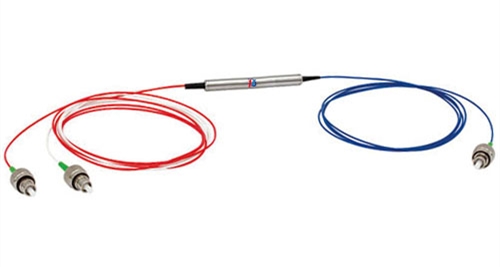To fulfill the requirement of communication efficiency, network technicians generally use optical circulator in a fiber optic system as it reduces the loss of light. An optical circulator is a small yet powerful device used in optical communication systems. The device is typically used to separate optical signals that (in an optical fiber) travel in opposite directions.

Functioning Principle and Components
Optical circulators usually consist of a polarizing beam splitter, Faraday rotator, reflector prism, birefringent blocks, and a retardation plate. The functioning of an optical circulator is a little similar to optical isolator. A light which travels in one direction right through the Faraday rotator will have its polarization rotated in one specific direction. A light that enters the rotator from the opposite direction will have its phases rotated in the opposite direction (sometimes may depend upon the propagation direction of the light).
In other words, light always rotates in one direction in accordance with the rotator regardless of its traveling direction.
Three-port optical circulator is widely used so let’s discuss that first. A signal in a three-port optical circulator is transmitted from 1st port to 2nd port where another signal is transmitted from 2nd to 3rd and additionally, a third signal can also be transmitted from 3rd to 1st.
Types
As per the Polarization Characteristics
If we talk about the characteristics based on the optical circulator’s polarization capabilities, they can be divided into two major types:
PM – Polarization Maintaining
PI – Polarization Insensitive
Each PM optical circulator typically comes in the market with a polarization maintaining fiber which makes it an ideal component for applications where it is necessary to maintain polarization, for example, Raman pump applications, 40Gbps systems, etc.
Polarization insensitive optical circulator is a small lightwave component which delivers high-performance functioning. The component comes in the market having features like low insertion loss, high isolation, high stability and reliability, and low polarization-dependent loss (PDL).
It is high in demand in combination with fiber gratings and other reflective components in close-packed wavelength-division multiplexing (DWDM) systems, high-speed systems and bi-direction communication systems.
As per the number of ports availability
Optical circulators fall into three main types when it comes to the number of ports:
3-port
4-port
6-port
3-port and 4-port optical circulators are commonly used way more than the 6-port optical circulations. In such circulators, optical light that is transmitted from any port can easily be redirected to any other port, regardless of the port-type.
An optical circulator is very commonly applied in a long list of applications within a fiber communication system. In modern optical communication systems, the optical circulator is usually used for wavelength division multiplexing networks, optical time domain reflectometers, fiber amplifier systems, bi-directional transmissions, etc.
With primary characteristics such as high isolation, low crosstalk, low insertion loss, and large bandwidth, the optical circulator can also become an in-built component of the same device as transmitters, amplifiers, and receivers.